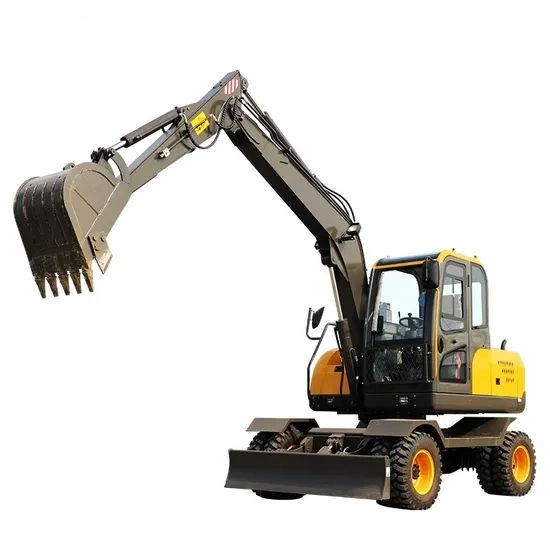A 1-ton wheeled excavator is an ultra-small construction machine. With the characteristics of "compact size, flexible mobility, and easy operation", it performs exceptionally well in narrow spaces and fine operation scenarios, especially suitable for small-scale projects, indoor operations, or scenarios with low requirements for site damage. The following are its main applicable fields and specific operation contents:

- Wall Demolition and Ground Breaking: For partial demolition of homes, shops, and small office buildings, there is no need for large-scale equipment. It can enter the room through narrow doorways (usually with a width of less than 1 meter) and, with the breaker attachment, break floor tiles and concrete cushions.
- Indoor Earthwork Removal: Excavation of foundations during renovation, excavation of sunken bathroom foundations, or cleaning of indoor construction waste (such as broken bricks and muck), avoiding the problem of low efficiency of manual handling.
- Sidewalk Renovation: Excavation of sidewalk tiles, digging tree pits (50-80 cm in diameter and within 1 meter in depth) for planting or replacing street trees.
- Burial of Underground Pipelines: Excavation of trenches for micro-pipelines (with a diameter of ≤100 mm) such as tap water, gas, and cables in residential areas or streets without damaging a large area of the road surface.
- Repair Around Manholes: Excavation of damaged concrete around manholes to facilitate re-pouring and avoid affecting pedestrian traffic.
- Operations in Greenhouses: Digging planting furrows, tilling the soil (30-50 cm in depth), or cleaning up straw and residual films in greenhouses. Due to the wheeled design, it causes little compaction to the greenhouse ground, avoiding damage to the soil structure.
- Fine Operations in Orchards/Vegetable Plots: Digging fertilizer furrows for fruit trees, transplanting seedlings, or leveling small vegetable plots, replacing manual hoes and spades to improve efficiency.
- Garden Renovation: Excavation of small ponds, construction of rockery foundations, and renovation of flower beds in villa or community gardens. It can accurately control the excavation range without damaging surrounding green plants.
- Lawn Renovation: Stripping the soil layer of old lawns, leveling the site to prepare for laying new lawns. The wheeled movement exerts low pressure on the ground, avoiding soil compaction that affects grass seed growth.
- Garbage Cleaning in Alleys and Hutongs: For the accumulation of construction waste and domestic garbage in narrow passages of old urban areas, it can be directly driven to the site for excavation and loading, and transported with small tricycles.
- Cleaning in Warehouses/Workshops: Breaking the ground in factory workshops, demolishing the foundations of old equipment, or cleaning up accumulated waste without the need to clear a large area of space.
- Short-Distance Transportation of Building Materials: Short-distance transportation (distance ≤50 meters) of building materials such as sand and cement, especially indoors or in corridors, which can replace wheelbarrows and reduce manual labor intensity.
- Shifting of Small Components: Light handling of small components (such as bricks and pipes) through the bucket or lifting attachments (which need to be adapted).
- Cleaning of Small Landslides and Ponds: Digging drainage ditches during urban waterlogging, or cleaning up ruins in narrow areas after earthquakes to open up channels for rescuers.
- Emergency Repair of Rural Roads: Excavation of foundations before filling potholes in rural roads, or cleaning up snow on the road surface (with a snow plow attachment).
- Excavation of equipment foundations, ground leveling in small factory workshops, or handling of light raw materials (such as metal scraps and plastic particles). Due to its small size, it can move flexibly between production lines.
The core value of the 1-ton wheeled excavator lies in its "ability to work in small spaces" and "low destructiveness":
- The width of the machine body is usually 0.8-1.2 meters, and the height is 1.5-2 meters. It can pass through corridors, courtyard doors, and elevators (some can be transported after being disassembled), suitable for scenarios where large equipment cannot enter.
- The wheeled design is lighter than the tracked one, exerting low pressure on the ground. When operating on hardened roads, lawns, and indoor floor tiles, it is not easy to cause large-area damage.
- Equipped with various attachments (such as breakers, log grapples, and bulldozer blades), it can realize multiple functions such as "excavation, breaking, handling, and leveling" to meet the diverse needs of small-scale projects.
In short, it is an ideal tool for scenarios with "small project quantities, high precision, and narrow spaces", especially suitable for individual businesses, small construction teams, or users who need flexible operations.






